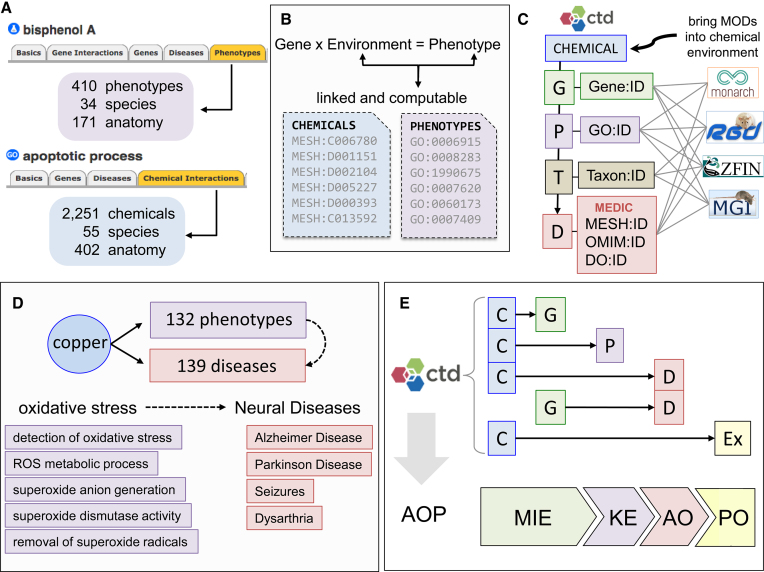Figure 2.
Using chemical–phenotype data for discovery. (A) Users can explore phenotypes from a chemical perspective (e.g. bisphenol A influences 410 phenotypes in 171 anatomical sites from 34 species) as well as discover chemicals that affect a specific phenotype (e.g. apoptotic process is modulated by 2,251 chemicals in 55 species). (B) Use of hierarchical controlled vocabularies (with accession identifiers) for both chemicals (MESH:ID) and phenotypes (GO:ID) provides data files that allow environmental factors and phenotypes to be linked and computable for meta-analyses. (C) Use of interoperable accession identifiers for genes (G), phenotypes (P), taxa (T), and diseases (D) shared by model organism databases (MODs) and other resources enable their content to be integrated with and brought into the chemical environment of CTD. (D) Non-disease phenotypes can be inferred to diseases (based on shared interacting chemicals) to help inform the pre-disease state. The heavy metal copper modulates 132 phenotypes and, independently, is associated with 139 diseases in CTD, providing a view of the potential biological processes in the presymptomatic condition, such as the numerous oxidative stress phenotypes that might precede the onset of neurological diseases. This knowledge can be leveraged to find novel commonalities between sets of phenotypes and diverse diseases, with the potential of re-purposing or discovering new therapeutic drugs. (E) Integrating data from all four CTD modules helps generate predictive adverse outcome pathways (AOP). CTD’s toxicogenomic core reports chemical–gene (C–G) interactions that parallel the molecular initiating event (MIE) of an AOP, CTD’s new phenotype module links chemical–non-disease phenotype (C–P) key events (KE), disease core curates chemical–disease (C–D) and gene–disease (G–D) adverse outcomes (AO), and CTD’s exposure module relates chemical exposures (C-Ex) for population-level health outcomes (PO).

